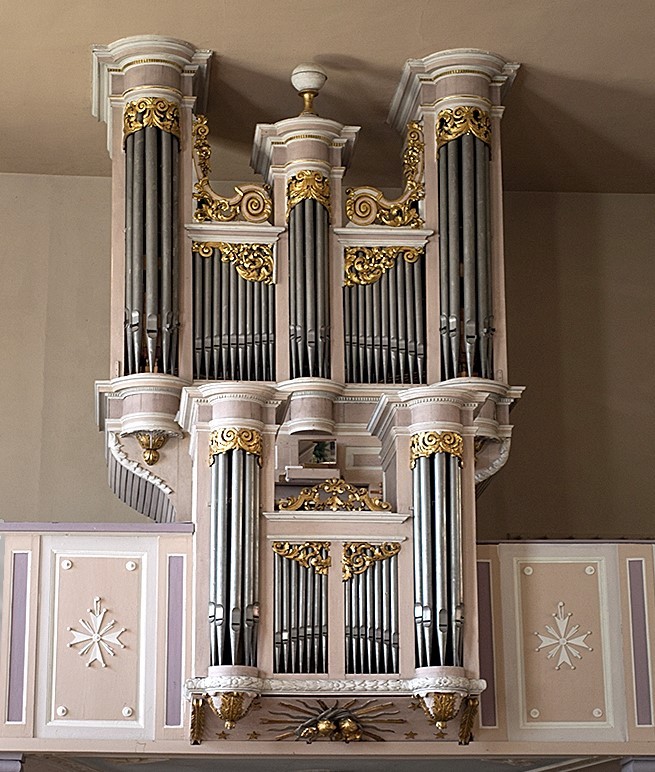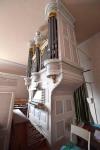Description complète d'orgue sélectionné

Photo: Yves Koenig
Hellimer, France (Moselle (57)) - Église Saint-Martin
Commune: Hellimer
Région:Lorraine
Adresse: Rue Saint-Martin, 57660, Hellimer
Description no.: 2051718.
Bâti par: Claude Legros (ca. 1690)
Données techniques
Composition
Grand Orgue (CD-d'''): Montre 8', Bourdon 8', Prestant 4', Flûte à Cheminée 4', Doublette 2', Plein-Jeu 5 rangs, Trompette 8', Clairon 4', Tremblant.
Positif (CD-d'''): Bourdon 8', Montre 4', Nazard 2 2/3', Doublette 2', Tierce 1 3/5', Cymbale 3 rangs, Cromorne 8', Tremblant.
Pédale (C-f'): No stops present.
Accouplements: Accouplement du Positif au Grand Orgue, Tirasse Grand Orgue, Tirasse Positif.

Photo: Yves Koenig
Hellimer, France (Moselle (57)) - Église Saint-Martin
Commune: Hellimer
Région:Lorraine
Adresse: Rue Saint-Martin, 57660, Hellimer
Description no.: 2051718.
Bâti par: Claude Legros (ca. 1690)
| Année | Facteur | Opus | Activité | ca. 1690 | Claude Legros | orgue neuf | ca. 1800 | Builder unknown | transfer | 1854 | Pierre Rivinach | restauration et expansion | 1887 | Jean-Frédéric (II) Verschneider | reconstruction | 1978 | Willy Meurer | restauration | 2020 | Yves Koenig | restauration et expansion |
- The Église Saint-Martin in Hellimer was built in 1740. A second-hand organ was installed probably during the time of the French Revolution. When installed, it was a small organ with one manual and an attached pedal, but it had originally been a two-manual organ. The original location is unknown. There are various theories, which almost certainly concern a former monastery organ. Due to various characteristics, the work is attributed to Claude Legros and dated to the 1690s. The organ case may be older. The organ was certainly present in the church in 1807.
- In 1854 the organ was overhauled by Pierre Rivinach. He placed the bass pipes of the Montre 8', and widened the case to accommodate them. The old manuals with a compass of 48 keys (CD-c''') were replaced by modern ones with 54 keys (C-f'''). The mechanics of both manuals were rebuilt and the wind supply was renewed. Finally, Rivinach extended the organ with an independent pedal with four stops and the disposition was romanticized.
- The Verschneider company worked on the organ in 1886-1887. This work was in fact carried out by Xavier Glock, who had led this firm since the death of Jean-Frédéric II in 1884. It is theorized that he placed a Cavaillé-Coll organ in the old case, taken from the chapel of a convent in Paris. But a lot of old Legros pipework is still present in the organ, so this theory has remained unclear. The original prospect pipes were removed in 1917.
- In 1970 a restoration started by Willy Meurer. Advisor was Albert Raber. The instrument was disassembled, but the restoration was not completed, and was ended in 1978. Only a few registers continued to function. Part of the old pipework has been lost. The rest was stored by him and could be used in the latest restoration. This was carried out in 2019-2020 by the Koenig company. In addition to the restoration of the Grand Orgue, the Positif has been restored to function with seven new registers, made in the Legros style.
Données techniques
| Nombre de registres par manuel | |
| - Grand Orgue | 8 |
| - Positif | 7 |
| - Pédale | 0 |
| Nombre de jeux total | 15 |
| Transmission des clés | Mechanical |
| Transmission des jeux | Mechanical |
| Sommier(s) | Slider chests |
Composition
Grand Orgue (CD-d'''): Montre 8', Bourdon 8', Prestant 4', Flûte à Cheminée 4', Doublette 2', Plein-Jeu 5 rangs, Trompette 8', Clairon 4', Tremblant.
Positif (CD-d'''): Bourdon 8', Montre 4', Nazard 2 2/3', Doublette 2', Tierce 1 3/5', Cymbale 3 rangs, Cromorne 8', Tremblant.
Pédale (C-f'): No stops present.
Accouplements: Accouplement du Positif au Grand Orgue, Tirasse Grand Orgue, Tirasse Positif.
| Autres données des dispositions | |
|---|---|
| Autres dispositions |
The specification before 2020 was: Grand Orgue (C-d'''): Montre 8', Bourdon 8', Prestant 4', Doublette 2', Trompette 8', Clairon 4', Tremblant. Positif: Prepared for. Pédale (C-f'): No stops present. Tirasse Grand Orgue. |
| Lièns |
http://www.orgues-koenig.com/hellimer-saint-antoine/ http://orgue.free.fr/of57-191.html |
 |
